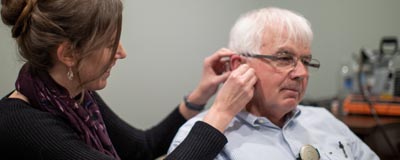Whether you are a career musician or a musical enthusiast, your constant exposure to playing an instrument may make you vulnerable to music induced hearing loss. There is no question that being exposed to music at a high volume for a long period of time will cause permanent damage to your hearing. We covered the risk caused by listening to loud music and attending concerts in our previous article on millennials and noise induced hearing loss. This time we will look at how hearing loss can affect musicians practicing and performing. We will also examine some of the solutions available to avoid and/or minimize any damage.
Why are musicians at risk of hearing loss?
A great deal of music uses large variations in the volume to create mood and emotion in the piece. Despite the use of microphones and speakers, musicians still have to play their instruments quite loudly to create the right sound. When performing, they often have to play loud enough to reach the entire venue. Classical music uses different terms to differentiate these volume levels. The extremes of which are piano, meaning “soft” and forte, meaning “loud”. A piece of music played forte on a piano will typically measure around 90 dB. It can be even higher if played in a small room. This level is within the danger zone for noise induced hearing loss. Many other acoustic instruments such as brass, percussion, violin, bag pipes, etc. can easily be played at even louder levels. Amplified instruments can get well above 110 dB.
Does the genre of music affect the risk?
Typically, genres such as classical music and jazz are played quieter than rock or pop concerts. Although quieter, classical performances can often reach an average volume of over 100 dB. Rock concerts can approach 120 dB when you blend their amplified music with screaming fans. Therefore both can be dangerous to your hearing without the appropriate protection.
What are the recommended earplugs?
The problem with most hearing protection is that it provides different levels of attenuation for different frequencies. This distorts the overall sound quality of music in a very negative way. Special musicians earplugs have been designed for that specific reason. They ensure that the music will maintain the same quality, only quieter. These maintain the quality and balance of the music while also protecting your hearing system.
We carry the Etymotic Research brand of custom musicians plugs which offer interchangeable filters with 9, 15 and 25 dB of attenuation. These top of the line musicians earplugs are made specifically for each user by taking an exact impression of their ear canal. This ads increased comfort for those who will be frequently wearing them. The 25 dB version would render a potentially damaging band practice noise level of 90dB down to a safe listening volume. We can help you choose the correct level of attenuation for your specific instrument and playing environment.
We also carry a less expensive, non-custom model. These generic ETY musicians plugs offer a standard 20 dB attenuation with the same sound quality benefits. These come in two different sizes – standard and large. These are perfect for those individuals who perform for shorter periods and don’t need the extra comfort of the custom models.
Click here to get more information about these ear protection options for musicians and music enthusiasts. If you have more questions about your hearing health or are unsure of which earplug will be best for you, please visit us at one of our locations in the Ottawa region.






